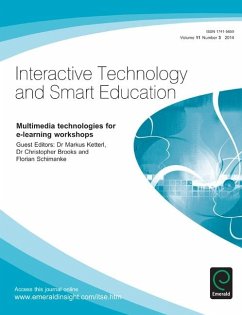Multimedia has become a central fixture in higher education learning environments. From highly polished video produced for Massive Open Online Courses (MOOCs) or the flipped classroom, to the extremely authentic recordings of lectures as they happen in lecture capture environments, instructional content is regularly delivered via video to learners across platforms, devices, and contexts. Much different than video based learning even a decade ago, the instructor is not the sole producer of video in the teaching and learning enterprise; user generated content is regularly produced by learners themselves, a task that has been made easier by the prevalence of recording technologies such as cell phone cameras and low cost video hosting platforms such as YouTube and Vimeo.At a technical level, the creation of educational video content spans both the hardware and software domains. In the last several years we have seen sustained innovation in each with the development of new kinds of video sensors, codecs, and playback environments. For instance, many researchers have begun to innovate on top of the 3D mesh mapping provided through Microsoft's Kinect to provide novel immersive environments. These environments offer increased interactivity in the video stream, allowing for objects to be detected relative to one another easily. Much of the innovation on the software side has taken place in deepening the connection between video artifacts and the rest of the learning environment. This allows video to be leveraged more holistically, with learners being able to cut, remix, comment on, annotate, reference, and republish content.The IEEE International Workshops on Multimedia Technology for E-Learning (MTEL) are held in conjunction with the annually IEEE International Symposium on Multimedia (ISM). This workshop series, now entering its ninth year, brings experts together from a variety of fields to share innovations in educational media. Three of the articles in this special issue of Interactive Technology and Smart Education are the revised and significantly enhanced versions of outstanding papers presented at the MTEL 2012 and MTEL 2013 workshops held in Irvine and Anaheim, California, USA. The fourth article is an invited contribution from the Opencast community, which is made up of scholars, engineers, and educational technologists who collaborate to produce open source educational video systems.Of the four articles in this issue, two focus on addressing the need for affordable and robust automated camera tracking systems for lecture recording in academia and present different approaches. The first idea relies on Microsoft's Kinect technology, while the second solution presents an open source project for the automatic control of pan-tilt-zoom (PTZ) cameras. Both contributions elucidate technical details and present results from field tests and user evaluations, and both provide important contributions in moving lecture capture quality closer to the high quality video today's learners expect. The third paper in this issue addresses spaced repetition learning games on mobile devices, and provides both a theoretical background for the issue and a prototype application. Early evaluation results and a design consideration discussion help to implement the spaced repetition approach in mobile learning games with a special focus on the stress field between motivation and spaced repetitions. The last article addresses the issue of user-annotation of time-based educational media, and the authors present a requirement analysis along with different didactic use cases in this area. Parts of the use cases are implemented in a prototype that is addressed in the technical section of the paper.These four papers represent well the diversity of submissions the MTEL workshop series receives on an annual basis, ranging from hardware implementations, to software prototypes and design studies. We look forward to future meetings of the workshop, and know you'll find the results presented here valuable in understanding the state of the art in research on multimedia technologies for e-learning.
Dieser Download kann aus rechtlichen Gründen nur mit Rechnungsadresse in A, B, BG, CY, CZ, D, DK, EW, E, FIN, F, GR, HR, H, IRL, I, LT, L, LR, M, NL, PL, P, R, S, SLO, SK ausgeliefert werden.


